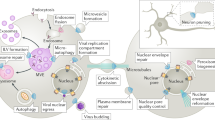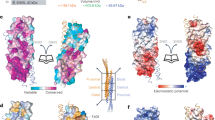Abstract
RETENTION of resident proteins in the lumen of the endoplasmic reticulum is achieved in both yeast and animal cells by their continual retrieval from the cis-Golgi, or a pre-Golgi compartment1–3. Sorting of these proteins is dependent on a C-terminal tetrapeptide signal, usually Lys-Asp-Glu-Leu (KDEL in the single letter code) in animal cells, His-Asp-Glu-Leu (HDEL) in Sac-charomyces cerevisiae2,4,5. There is evidence that the ERD2 gene encodes the sorting receptor that recognizes HDEL in yeast6,7; its product is an integral membrane protein of relative molecular mass 26,000 (26K) that is not glycosylated. In contrast, Vaux et al.8 suggest that the mammalian KDEL receptor is a 72K gly-coprotein that they detected using an anti-idiotypic antibody approach. If this were so, it would indicate a surprising divergence of the retrieval machinery between yeast and animal cells. We report here that human cells express a protein similar in sequence, size and properties to the ERD2 product, and propose that this protein is the human KDEL receptor.
This is a preview of subscription content, access via your institution
Access options
Subscribe to this journal
Receive 51 print issues and online access
$199.00 per year
only $3.90 per issue
Buy this article
- Purchase on Springer Link
- Instant access to full article PDF
Prices may be subject to local taxes which are calculated during checkout
Similar content being viewed by others
References
Pelham, H. R. B. EMBO J. 7, 913–918 (1988).
Pelham, H. R. B. A. Rev. Cell Biol. 5, 1–23 (1989).
Dean, N. & Pelham, H. R. B. J. Cell Biol. 111, 369–377 (1990).
Munro, S. & Pelham, H. R. B. Cell 48, 899–907 (1987).
Pelham, H. R. B., Hardwick, K. G. & Lewis, M. J. EMBO J. 7, 1757–1762 (1988).
Semenza, J. C., Hardwick, K. G., Dean, N. & Pelham, H. R. B. Cell 61, 1349–1357 (1990).
Lewis, M. J., Sweet, D. J. & Pelham, H. R. B. Cell 61, 1359–1363 (1990).
Vaux, D., Tooze, J. & Fuller, S. Nature 345, 495–502 (1990).
Saiki, R. K. et al. Science 239, 487–491 (1988).
Simmons, D. & Seed, B. Nature 333, 568–570 (1988).
Dohlman, H. G., Caron, M. G., Strader, C. D., Amlaiky, N. & Lefkowitz, R. J. Biochemistry 27, 1813–1817 (1988).
Dixon, R. A. F., Sigal, I. S. & Strader, C. D. Cold Spring Harb. Symp. quant. Biol. 53, 487–497 (1988).
Roth, J. & Berger, E. G. J. Cell Biol. 93, 223–229 (1990).
Saraste, J. & Kuismanen, E. Cell 38, 535–549 (1984).
Warren, G. Nature 327, 17–18 (1987).
Kyte, J. & Doolittle, R. F. J. molec. Biol. 157, 105–132 (1982).
Author information
Authors and Affiliations
Rights and permissions
About this article
Cite this article
Lewis, M., Pelham, H. A human homologue of the yeast HDEL receptor. Nature 348, 162–163 (1990). https://doi.org/10.1038/348162a0
Received:
Accepted:
Issue Date:
DOI: https://doi.org/10.1038/348162a0
This article is cited by
-
The K/HDEL receptor does not recycle but instead acts as a Golgi-gatekeeper
Nature Communications (2023)
-
ACBD3 modulates KDEL receptor interaction with PKA for its trafficking via tubulovesicular carrier
BMC Biology (2021)
-
KDEL receptor is a cell surface receptor that cycles between the plasma membrane and the Golgi via clathrin-mediated transport carriers
Cellular and Molecular Life Sciences (2021)
-
Transcriptomics of a KDELR1 knockout cell line reveals modulated cell adhesion properties
Scientific Reports (2019)
-
KDELR2 Promotes Glioblastoma Tumorigenesis Targeted by HIF1a via mTOR Signaling Pathway
Cellular and Molecular Neurobiology (2019)
Comments
By submitting a comment you agree to abide by our Terms and Community Guidelines. If you find something abusive or that does not comply with our terms or guidelines please flag it as inappropriate.



